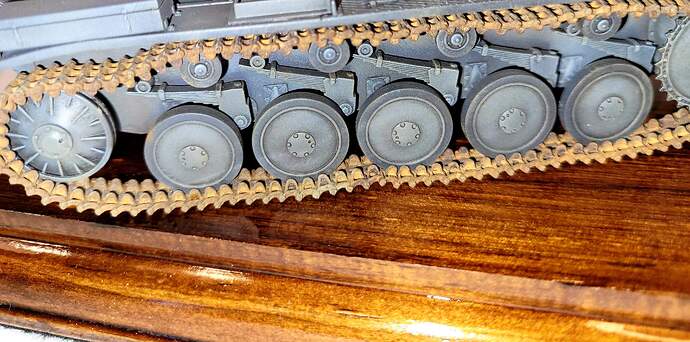I’m pretty sure his track shoes are black or dark gray.

Isn’t silver the universally agreed color?
Joking of course:) On to the fun stuff.
@Johnnych01 John is  % On The Mark about realistic looking tracks from what I’ve seen & researched for the typical tank. That’s the driving philosophy for trying to get tracks to look great in my experience.
% On The Mark about realistic looking tracks from what I’ve seen & researched for the typical tank. That’s the driving philosophy for trying to get tracks to look great in my experience.
Since I haven’t witnessed a running WW2 German AFV to have first hand knowledge, I think the WW2 German AFV’s will pick up some metallic shine on their tracks on the contact points. My artist license favors sparingly used silver for that highlight.
Old Original Tamiya Rubber bands tracks. These old birds are tough turkeys to cook up. Floquil Rail Road Antique Bronze thinned with a Zippo lighter fluid or similar solvent (lacquer thinner if you wish) to BITE into the track. Have sets 30+ years old that were done this way and held up fine.
Antique Bronze, painted Rubber Black pads, wash of rust & dirt.
New Formula Tamiya Rubber band tracks. Floquil Military Color Bronze, dirt & Rust wash with faint metal highlight. Have one done 25+ years ago that have held up no issues, shot with Zippo lighter fluid & Floquil etc.
Both models above would probably benefit from a little more pastel chalk dust to blend etc.
I also use the same procedure on plastic link tracks.
I like Tamiya Dark Iron as it’s close to the Floquil Antique Bronze & Floquil Military Colors Bronze. I think the Tamiya Dark Iron could look even better with a little tweaking. I would probably test adding a bit of brown or earth tone to lighten it slightly.
White Metal Burnishing
Of course, Fruil (recent quality has slipped) & Sector35 (outstanding) make white metal that could be worth a look. Burnishing fluids and sanding can yield this sort of result pretty easily.
@SdAufKla Mike, kindly did a very nice write up on the old forum for working metal tracks. The Pz IV tracks above are based on following it
Armorama::Birchwood Casey Liquid Gun Blue 1
White Metal Painted
Without burnishing fluids or weak burnishing, the following results are easy on white metal tracks with Floquil
Antique Bronze or Floquil Military Color Bronze, dirt & Rust wash. Tweaked Tamiya Dark Iron should work similarly.
Starting with a fairly dark gray base coat etc and apply paints as washes etc.
This starting to drift towards too heavy in effect in my opinion. These will need to be lightly sanded on contact points to expose some silvery metal and then toned down and blended with a bit of pastel chalk dust with the model.
Painted white metal with chalk dust.





























